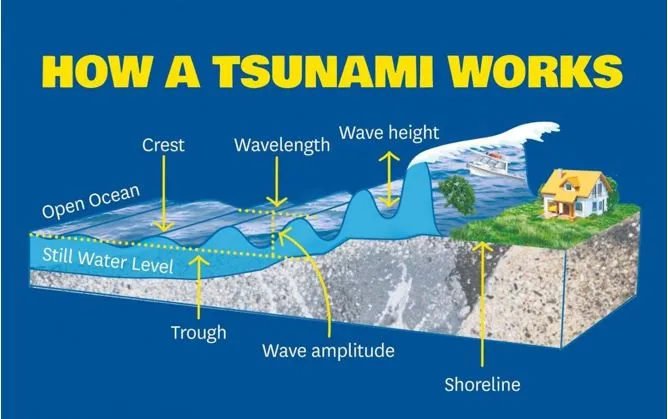

16th October 2024 (13 Topics)
Context
The Indian National Centre for Ocean Information Services (INCOIS) in Hyderabad has issued advisories regarding swell waves affecting the Andaman and Nicobar Islands, Lakshadweep, and various coastal regions in India, including Andhra Pradesh, Goa, Gujarat, Kerala, Maharashtra, Odisha, Tamil Nadu, West Bengal, Daman and Diu, and Puducherry.
What are Swell Waves?
- Swell waves are long-wavelength ocean waves that travel away from their points of origin, typically created by windstorms or other weather systems.
- Unlike local sea waves, which are generated by nearby winds, swell waves carry energy across vast distances.
- This energy transfer occurs when windstorms and powerful air currents impact the water surface, resulting in waves that are more potent than their locally generated counterparts.
Characteristics of Swell Waves
- Energy and Distance: Swell waves have higher energy levels, enabling them to travel long distances with minimal energy loss. This characteristic allows them to strike coastal areas with considerable power.
- Wave Organization: Swell waves tend to organize into groups with similar heights and periods. The "wave period" refers to the time taken for one wavelength to pass a specific point. Longer wavelengths correlate with longer wave periods, signifying faster and more powerful waves.
- Power and Persistence: A wave represents a transfer of energy; thus, longer waves, which dissipate energy more slowly than shorter waves, can persist for days after their formation. This persistence is critical for coastal communities as it affects safety and preparedness.
Forecasting Swell Waves in India
- INCOIS launched a swell surge forecast system in February 2020 to provide timely warnings to coastal populations about impending swell waves.
- The significance of this system is underscored by the colloquial term "Kallakkadal waves," used by Kerala fishermen to describe sudden and hazardous wave surges that can lead to flash floods.
- This term has gained scientific acceptance through recognition by UNESCO.
Differences Between Swell Waves and Tsunami Waves
- Tsunamis are massive ocean waves primarily caused by underwater earthquakes or volcanic eruptions. As they approach shorelines, their height significantly increases due to shallower waters.
- Key Characteristics
- Speed: Tsunami waves can travel at speeds up to 500 miles (805 kilometers) per hour in deep water, slowing down but gaining height as they near the coast.
- Misconception: Often called "tidal waves," tsunamis are not related to tides and are distinct phenomena.
- Causes
- Earthquakes: Most tsunamis are triggered by significant underwater earthquakes, particularly at tectonic plate boundaries.
- Geological Activity: About 80% occur in the "Ring of Fire" in the Pacific, known for intense geological activity.
- Other Triggers: Underwater landslides, volcanic eruptions, and historical meteorite impacts can also cause tsunamis.

Key-Difference |
||
|
|
Swell Waves |
Tsunami Waves |
|
Causes |
Kallakkadal waves arise from meteorological conditions and are influenced by atmospheric phenomena |
Tsunamis primarily result from geological activities, such as underwater earthquakes or tectonic movements. |
|
Nature of Surges |
Kallakkadal waves tend to inundate coastal areas rapidly, often leading to sudden flash floods |
Tsunamis can cause extensive destruction and travel at much higher speeds across the ocean. |
More Articles


